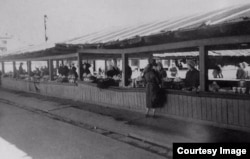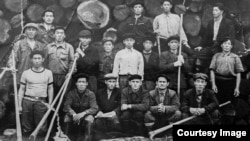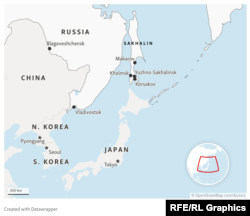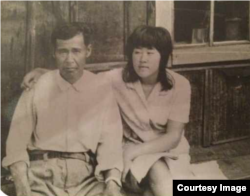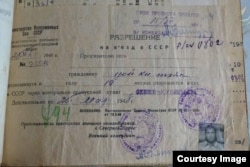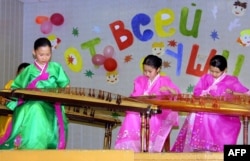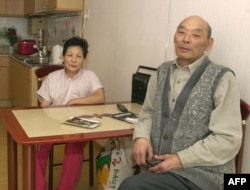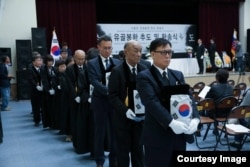Lyudmila Kim has one of the best gardens on Sakhalin.
Often, visitors to this remote island, which lies between Russia’s Far Eastern coast and northern Japan, are taken there to see the roses, rhododendrons, and rare varieties of conifers she cultivates.
It’s a place where everything seems to grow. Except vegetables.
“Don’t even talk to me about cucumbers and tomatoes,” she says. “For me, this has been a horror since childhood.”
Kim’s aversion to vegetable growing is not surprising, given that it reminds her of her tough upbringing as part of a family of ethnic Koreans who ended up stranded here after the end of World War II when the island was taken over by the Soviet Union.
Left abandoned in a strange land with little knowledge of Russian and frequently no official documents, these migrants often grew their own food to help ensure their survival.
“From the age of 5, I remember myself with a hoe: weeding, hilling, watering…. I’m already over 60, and I still hate the garden,” Kim told RFE/RL's Siberia.Realities.
The gardening efforts of Kim’s family and many other Korean Sakhalins, however, have left their mark on this 945-kilometer-long island of some 500,000 people, where Korean produce is now commonplace in local restaurants, markets, and grocery stores -- just one of many signs of the impact and influence the Korean community has had on this part of Russia.
Although a few Korean emigrants arrived on the island in the 19th century, having traveled to the Russian Empire in search of work, Kim descends from those who began to be brought here after Russia and Japan divided Sakhalin between them at the end of the Russo-Japanese War in 1905, with Moscow taking the northern half and Tokyo administering the southern part.
The vast majority of these people were recruited as laborers from southern Korea by the Japanese for the portion of the island they controlled, known as the prefecture of Karafuto.
Their numbers increased greatly as the Japanese war machine gained momentum in the 1930s and '40s.
With many Japanese men mobilized for military purposes during World War II, Tokyo looked to Korea, which it had annexed in 1910, to meet Karafuto’s labor needs.
Although recruitment was initially voluntary, many Koreans were subsequently brought over as conscripted workers when Japan’s labor situation became increasingly fraught toward the end of the war. They were deployed to do the most strenuous jobs, such as mining coal, felling timber, building defensive fortifications, and laying roads and railways.
Working conditions were often horrendous. It’s said that there was a corpse under every sleeper on the Kholmsk-Yuzhno-Sakhalinsk railway line, which was laid through mountains by Korean laborers.
There were tens of thousands of Korean workers on Sakhalin during the war, and some 45,000 were still living there by the time Moscow wrested control of the whole island from Japan in August 1945.
Although more than 300,000 Japanese civilians who remained on Sakhalin were safely repatriated after the conflict, many Koreans were not so lucky.
Tokyo would not take responsibility for more than 40,000 of them, and they were not accepted for repatriation, leaving them adrift and far from home.
'Mountain Of Weeping'
A monument on a peak by the seaside town of Korsakov, known as the “Mountain of Weeping,” stands today as a reminder of these traumatic times, when crowds of Koreans gathered on Sakhalin’s southern shores, scanning the horizon for ships to take them home.
According to historian Yulia Din, Koreans made long journeys to the coast and waited "for several days" before finally heading back in despair.
A lot of them would never see Korea again.
With Korea being divided into northern and southern occupation zones after the war by the United States and the U.S.S.R, the Soviet military subsequently agreed with authorities in Pyongyang on the mass relocation of Koreans from Sakhalin to North Korea, which was supposed to begin at the start of 1948.
These plans soon fell by the wayside, however, after the local communist administration urged Moscow to keep this source of cheap labor “inherited” from Japan. The first secretary of the regional committee even bombarded Moscow with telegrams, saying that the repatriation of Koreans was “inexpedient” and should be postponed.
No transportations were implemented in 1948-49, and repatriation then became impossible after the Korean War broke out in 1950.
One of those left marooned on the island was So Su San, who had ended up in Sakhalin after leaving Korea to work in Japan in the early 1940s. He left a wife, 5-year-old son, and 3-year-old daughter behind.
So Su San had worked at a pulp and paper plant in the city of Makarov under the Japanese and he remained there after the war.
With all hope of returning home thwarted, he eventually started a second family on Sakhalin and had three children with a local woman.
San’s granddaughter Ilona An remembers him as being typical of his generation of Sakhalin Koreans, who were “generally very silent” and “held so much pain inside themselves.”
“Of course, the never-healing wound for my grandfather was the family that remained in Korea,” she says. “He was never able to see the children and did not receive news from them.”
Stateless And Marginalized
Over time, as the Cold War took hold and international interest in the plight of Sakhalin Koreans dwindled, the Soviet Union began issuing its own passports to Koreans. This program was curtailed a few years later under pressure from communist North Korea, which claimed the Sakhalin Koreans as its own and offered them citizenship, even though they were most mostly from the southern part of Korea.
Although formally Koreans could still officially obtain a Soviet passport, they often faced insurmountable bureaucratic difficulties in attaining it, and so many took up Pyongyang’s offer of citizenship rather than face the difficulties of being undocumented. Although some actually emigrated to North Korea, there was no mass exodus as word spread of the brutal regime that prevailed there.
According to the regional internal affairs directorate, by the early 1960s, out of 43,000 Sakhalin Koreans, 25,000 had become North Korean citizens while 13,000 had accepted Soviet citizenship. Much of the remainder, however, remained stateless, still hopeful of returning home to southern Korea.
The dubious legal status of these undocumented Koreans caused them many difficulties. They had to register with the police and even required permission from the authorities to travel to another district.
Te Sen Pak, who was born in 1964, recalls an unsanctioned visit to see his ailing grandfather. Unable to quickly get official permission to see him in the village where he lived, Pak and his mother made a stressful clandestine journey there by bus and train to see his grandfather before he passed.
The return trip was even more nerve-wracking. Arriving at a train station in Yuzhno-Sakhalinsk too late to take a bus home to nearby Korsakov where they lived, they found that no taxi driver would take them the rest of the way as they knew the pair had no travel permit.
Eventually, they persuaded one driver to bring them home for the then-exorbitant sum of 25 rubles.
“All the way, my mother’s heart was pounding,” Pak says. “They could have put her in a holding cell simply for crossing the city without permission. After all, we were stateless people back then -- persons without any rights or freedom.”
And yet, despite the difficulties, these undocumented Koreans endured. In 1985, nearly 10,000 of Sakhalin’s sizable Korean community were still stateless.
Dual Identity
For many ethnic Koreans who were born in Sakhalin after the war, growing up in Russia left them grappling with a dual identity.
“When I started asking where we came from or why my classmates’ grandfathers were veterans and mine didn’t fight, the adults curtailed these conversations,” says Viktoria Tsoi, who grew up on Sakhalin and has written a novel about the fate of its Korean community. “They wanted to protect me, saying that being an ordinary Soviet pioneer would be enough.”
According to Tsoi, the Soviet state also had a similar attitude.
“Korean schools were closed…; there were no Korean cultural centers; we did not study the language or our history,” she says. “Probably, the authorities believed that if we were torn away from our roots, we would become simply citizens of the U.S.S.R.”
As the political situation in the Soviet Union thawed in the 1980s, however, Tsoi says many Sakhalin Koreans began to feel more at home.
“Perestroika began, and everything changed,” she says. “And now on Sakhalin, the Korean language is studied at the university, there is a school where children can study the Korean language, and children of all nationalities study Korean culture at the art school.”
Nowadays, many of the descendants of the southern Korean laborers drafted to work on the island of Sakhalin have been largely Russified, although they are still keenly conscious of their origins and maintain active contact with South Korea, with about one-third of Sakhalin’s some 25,000 ethnic Koreans having visited there at least once.
“I have two homelands: Russia and Korea…” says Tsoi. “It’s impossible to choose [between them], and it’s not necessary. I am a Russian-Korean, and my multiculturalism is a great advantage when East and West coexist in one person.”
The Long Road Home
Although over time subsequent generations of Sakhalin Koreans increasingly came to feel more comfortable and accepted on the island, many of their older counterparts dreamed for decades of returning to their homeland.
Their hopes received a major boost in 1985 when, after years of campaigning by activists in Korea and Japan, the Japanese government finally agreed to finance the repatriation of first-generation Sakhalin Koreans born before August 15, 1945.
Tokyo also paid for plane tickets to facilitate meetings with relatives, and in 1990 a TV broadcast was held between Tokyo and Seoul that gave many elderly Koreans a chance to finally see and speak to each other via a video link after being separated for nearly five decades.
After the fall of the Soviet Union and the establishment of diplomatic relations between Russia and South Korea, many Sakhalin Koreans had the opportunity to finally visit their homeland.
In 1993, South Korea and Japan agreed on the repatriation of first-generation Sakhalin Koreans, with Japan contributing tens of millions of dollars as reparation for the labor they had been forced to do.
In the years that followed, an entire residential area was built for elderly returnees in the Korean city of Ansan and those who relocated were given health insurance and a pension. Around 4,000 elderly Sakhalin Koreans have since been repatriated.
Like thousands of his peers, however, all of this came too late for So Su San, who died in 1983.
All the same, he finally achieved a homecoming of sorts, when his eldest son traveled to Sakhalin, seeking to take his father’s ashes back to Korea like the remains of other Sakhalin Koreans which have been repatriated in recent decades.
“At first our family was indignant. How could we give them away?” say Ilona An. “But then we thought: They were never able to meet their father, although they lived in hope, and it would be right for him to return to them and for…grandfather’s memory to be honored."
